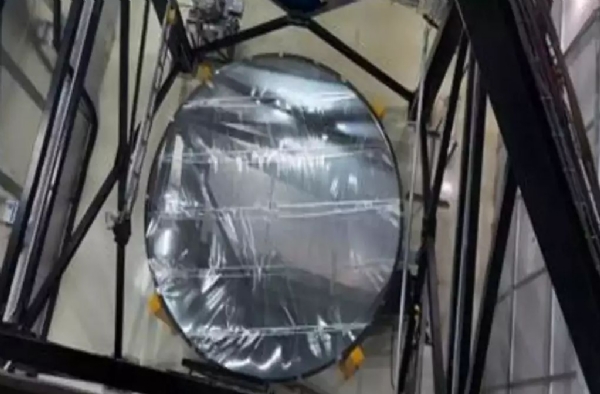For first time, India sets up Asia's largest Liquid-Mirror telescope in Uttarakhand's Devasthal
03 Jun 2022 14:31:56
In a major development, for the first time India has commisiioned a uniquw liquid miror telescope atop a mountain in the Himalayan range in the Uttarakhand to watch on the overhead sky to dertermine trasient or variable objects such as supernovae, gravitational lenses space debris and asteroids.

The telescope will help in surveying the sky making it possible to observe several galaxies and other astronomical sources just by staring at the strip of sky that passes overhead. Built by astronomers from India, Belgium and Canada, the novel instrument employs a 4-meter-diameter rotating mirror made up of a thin film of liquid mercury to collect and focus light, the Indian ministry said.
It is located at an altitude of 2450 meters at the Devasthal Observatory campus of Aryabhatta Research Institute of Observational Sciences (ARIES), an autonomous institute under the Department of Science and Technology (DST) situated in Nainital district, Uttarakhand. "The scientists from the three countries spun a pool of mercury which is a reflective liquid, so that the surface curved into a parabolic shape which is ideal for focusing light," the ministry said.
Explaining how the telescope functions, the ministry said that a thin transparent film of mylar protects the mercury from wind. "The reflected light passes through a sophisticated multi-lens optical corrector that produces sharp images over a wide field of view. A large-format electronic camera located at the focus records the images," it said.
Professor Paul Hickson (University of British Columbia, Canada), an expert on liquid mirror technology, said that "the rotation of the earth causes the images to drift across the camera, but this motion is compensated electronically by the camera. This mode of operation increases observing efficiency and makes the telescope particularly sensitive to faint and diffuse objects."
Liquid mirror telescope or ILMT is the first such telescope designed exclusively for astronomical observations installed at the Devasthal Observatory of ARIES, said Dipankar Banerjee, Director, ARIES.
Banerjee mentioned that Devasthal Observatory now hosts two four-meter class telescopes – the ILMT and the Devasthal Optical Telescope (DOT). "Both are the largest aperture telescopes available in the country," he said, adding that he was enthusiastic about the application of Big Data and Artificial Intelligence/Machine Learning (AI/ML) algorithms that will be implemented for classifying the objects observed with the ILMT.
"I am hopeful that this project will attract and motivate several young minds from scientific and engineering backgrounds to take up challenging problems," he said.
Project investigator of ILMT, Kuntal Misra said that the wealth of data generated with the ILMT survey will be exemplary. "In the future, several young researchers will be working on different science programs utilizing the ILMT data," he said.
Scientists said that when regular science operations begin later this year, the ILMT will produce about 10 GB of data every night, which will be quickly analyzed to reveal variable and transient stellar sources. The 3.6-meter DOT, with the availability of sophisticated back-end instruments, will allow rapid follow-up observations of the newly-detected transient sources with the adjacent ILMT.
"The data collected from ILMT will be ideally suited to perform a deep photometric and astrometric variability survey over a period of typically 5 years,” said Project Director Jean Surdej (University of Liège, Belgium and University of Poznan, Poland).
The telescope was designed and built by the Advanced Mechanical and Optical Systems (AMOS) Corporation and the Centre Spatial de Liège in Belgium.